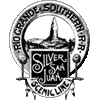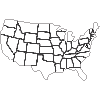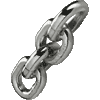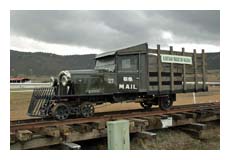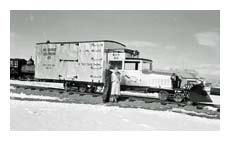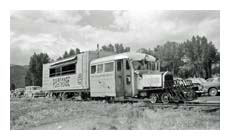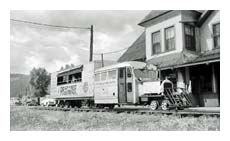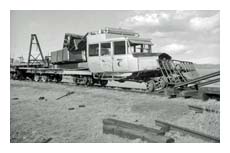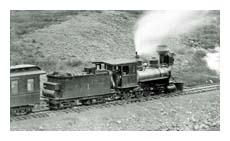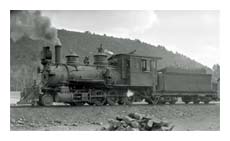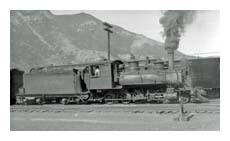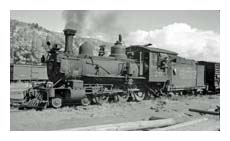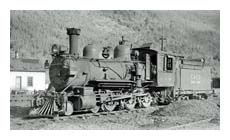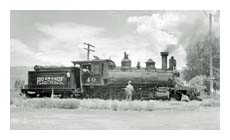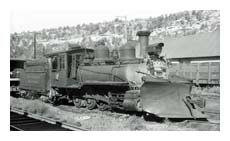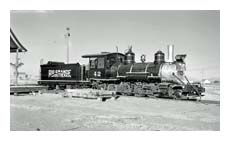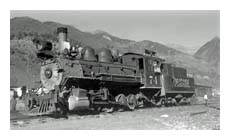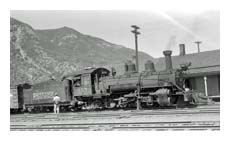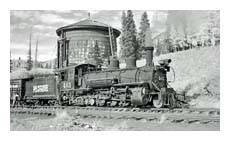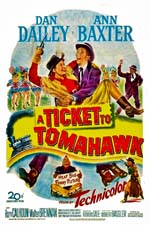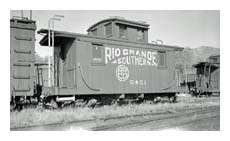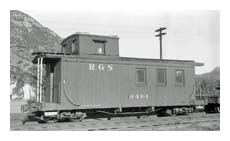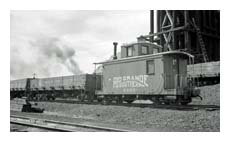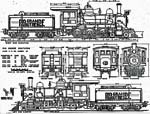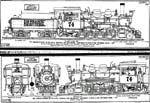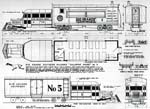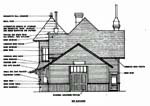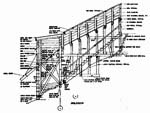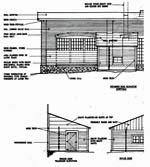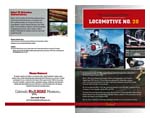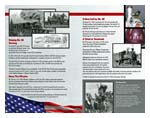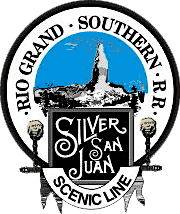

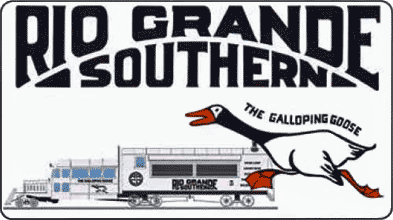
The Rio Grande Southern (see this map) managed to build a steep, twisting, 162 mile route west and north out of Durango through Dolores, Rico, and Ophir
 into Ridgway (with a short branch into Telluride) thereby connecting to the D&RGW at both ends.
into Ridgway (with a short branch into Telluride) thereby connecting to the D&RGW at both ends.The RGS survived for 60 years until 1952 (construction completed 1893, last train 1953) when it succumbed to the automobile as many other railroads did.
to the automobile as many other railroads did.
Follow that old RGS route through the San Juan Mountains, in photos, by clicking on the station names in the timetable below:
| RIO GRANDE SOUTHERN RAILROAD | ||
| West | DISTRICT 1 | East |
| Miles from Ridgway | STATION | Miles from Rico |
| 0.0 | Ridgway | 66.2 |
| 26.6 | Placerville | 39.6 |
| 37.8 | Vance Junction (Telluride Branch) | 28.4 |
| 44.9 | Ophir | 21.3 |
| 44.9 | ⭐⭐⭐ Structure ⭐⭐⭐ | 21.3 |
| 49.0 | Trout Lake | 17.2 |
| 52.6 | Lizard Head | 13.5 |
| 66.2 | Rico | 0.0 |
| RIO GRANDE SOUTHERN RAILROAD | ||
| West | DISTRICT 2 | East |
| Miles from Ridgway | STATION | Miles from Durango |
| 66.2 | Rico | 96.4 |
| 87.4 | Stoner | ?.? |
| 102.3 | Dolores | 60.3 |
| 122.5 | Mancos | 40.1 |
| 145.5 | Hesperus | 17.1 |
| 157.1 | Porter | 5.5 |
| 162.6 | Durango (D&RGW) | 0.0 |
| RIO GRANDE SOUTHERN RAILROAD | ||
| TELLURIDE BRANCH | ||
| Miles from Ridgway | STATION | Miles from Telluride |
| 37.8 | Vance Junction (Mainline) | 7.3 |
| 45.1 | Telluride | 0.0 |

The railroad's fortunes rose and fell with the mining industry and the national economy. In 1931, in the depths of the Great Depression, the RGS was in bankruptcy. One of its few reliable revenue sources was a contract to carry the U.S. mail. Carrying the mail on a high maintenance steam train with a crew of at least five was very expensive, so Superintendent Forest White and Receiver Victor Miller decided to try something different.
They decided to build a "rail bus" out of a used automobile, to be used to carry the mail, light freight, and a few passengers. Starting in mid-April, Chief Mechanic Jack Odenbaugh and Jack Martin converted a 1926 Buick Master Six into RGS Motor Number 1 in just six weeks at a cost of $828.55. On 1 Jun 1931 Motor 1 rolled out of the Ridgway shops. It looked like a strange blend of locomotive and pickup truck. Its first test run to Dallas Divide was so successful that it was sent on its first freight trip later the same day. It paid for itself in less than a month.
Number 1 worked so well that construction of more Motors began immediately. Number 2 was larger and was also Buick-based. By October 1936 the fleet was complete, with very large Motors 3, 4, 5, and 7 based on Pierce-Arrow limousines and Motor 6 built as a flatbed railroad maintenance vehicle. The large Motors were very distinctive, with Pierce-Arrow passenger compartments followed by articulated freight compartments that looked like boxcars.
The Motors were so successful that they now carried all passengers, the mail, and full loads of light freight, leaving the steam trains to haul ore and livestock. The RGS was able to cut costs enough that the railroad stayed in business for another 20 years.
Somewhere along the way, probably in the late 1930s, the Motors acquired the name "Galloping Geese". There are many stories regarding the origin of the name. One credits a railroad employee's wife, who disliked the contraptions and referred to them as "that... THING that looks like an ol' Galloping Goose!" It was also common in those days to refer to ungainly machines as some variety of goose, Ford's Tri-motor airplane was referred to as the Tin Goose, and Howard Hughes' gigantic seaplane was called the Spruce Goose. The Motors were certain ungainly, with horns that honked like geese, a waddling gait as they travelled down the uneven tracks, and they commonly travelled with open engine hoods to combat overheating. Whatever the origin, the unofficial name stuck and was officially adopted by the RGS in 1950.
After World War II, the Geese were refurbished with Wayne school bus bodies and surplus GMC truck engines. Loss of the mail contract, improved highways, and growth of the trucking industry seriously reduced the RGS's income. In 1950 the RGS attempted to promote itself as a tourist line, cutting windows into the freight compartments of the Geese and installing passenger seats. It was an idea too far ahead of its time. The RGS ceased operation in 1951.
Fortunately all of the Motors survived except Number 1, which was scrapped by the RGS in 1933 because it was too small. All of the others exist today and have become world famous. Numbers 2, 6, and 7 are at the Colorado Railroad Museum in Golden. Number 3 is at Knott's Berry Farm in California. Number 5 has been fully restored by the Galloping Goose Historical Society in Dolores, Colorado, and Number 4 sits next to the courthouse in Telluride.
In 2000 Karl Schaeffer of the Ridgway Railroad Museum built a fully accurate and operating replica of Motor 1, which is on display at the Ridgway Railroad Museum - Jim Pettengill - Ridgway Railroad Museum
Motor 5 version B - Left side three-quarter view of motor car from front end photographed at Durango after rebuilding - 26 Jul 1950 Robert W. Richardson - Denver Public Library call number RR-682.
Motor 6 version B - Right side three-quarter view of motor 6 from front end at washout near Muldoon, Colorado - 11 Oct 1952 Robert W. Richardson - Denver Public Library RR-718.
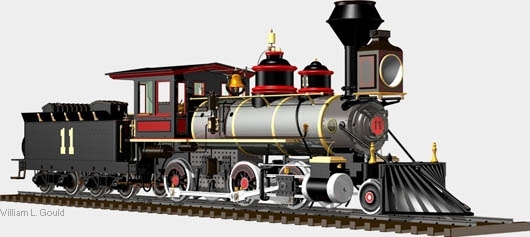
 included in the photos above. This locomotive was originally built by the Schenectady Locomotive Works in 1899 for the Florence & Cripple Creek Railroad. It worked there for thirteen years until 1916 when it was sold to the Rio Grande Southern for US$2,500. Following and overhaul by the DRGW in Alamosa it moved to Durango spending 35 years working the Rio Grande Southern. In august of 1943 the engine was double-heading behind RGS 40 when that locomotive derailed on an inside curve near milepost 142 pulling number 20 with it. Number 20's boiler was damaged in the incident but repaired at Ridgway and returned to service next spring. Number 20 became a movie star in the motion picture A Ticket to Tomahawk
included in the photos above. This locomotive was originally built by the Schenectady Locomotive Works in 1899 for the Florence & Cripple Creek Railroad. It worked there for thirteen years until 1916 when it was sold to the Rio Grande Southern for US$2,500. Following and overhaul by the DRGW in Alamosa it moved to Durango spending 35 years working the Rio Grande Southern. In august of 1943 the engine was double-heading behind RGS 40 when that locomotive derailed on an inside curve near milepost 142 pulling number 20 with it. Number 20's boiler was damaged in the incident but repaired at Ridgway and returned to service next spring. Number 20 became a movie star in the motion picture A Ticket to Tomahawk during 1949 when it was re-configured as the "Emma Sweeny" for the ficticious Tomahawk & Western Railroad. A one-time movie shot wasn't enough to pay the RGS bills so by 1951 the railroad was bankrupt. As a result Number 20 was retired then acquired by the Rocky Mountain Railroad Club. It was first displayed at the Narrow Gauge Motel at Alamosa, Colorado, until creation of the Colorado Railroad Museum at Golden, Colorado, in 1958.
during 1949 when it was re-configured as the "Emma Sweeny" for the ficticious Tomahawk & Western Railroad. A one-time movie shot wasn't enough to pay the RGS bills so by 1951 the railroad was bankrupt. As a result Number 20 was retired then acquired by the Rocky Mountain Railroad Club. It was first displayed at the Narrow Gauge Motel at Alamosa, Colorado, until creation of the Colorado Railroad Museum at Golden, Colorado, in 1958.It remained on display at Golden
 for 48 years with the exception of a stint in a movie and a television show until 2006 when an unknown benefactor showed up pledging several hundred thousand dollars to bring it into operational condition. There was a condition attached, the engine was to be re-built by the Strasburg Railroad in Pennsylvania.
for 48 years with the exception of a stint in a movie and a television show until 2006 when an unknown benefactor showed up pledging several hundred thousand dollars to bring it into operational condition. There was a condition attached, the engine was to be re-built by the Strasburg Railroad in Pennsylvania.Consequently Number 20 was prepared for truck transport down east and this photo shows the locomotive loaded on a flatbed trailer while passing through Vandalia, Illinois, on 2 Oct 2006.
down east and this photo shows the locomotive loaded on a flatbed trailer while passing through Vandalia, Illinois, on 2 Oct 2006.
Tracing its whereabouts and condition thereafter on the internet supplied little news but the locomotive obviously made it to the Strasburg as the next photo, taken at the Strasburg Railroad's backshop on 23 Nov 2007, shows Number 20's boiler moving across the backshop after being lifted from its frame. Just over a month later work commenced on straightening a portion of the boiler so a patch could be manufactured and installed. This next shot shows the front boiler course
moving across the backshop after being lifted from its frame. Just over a month later work commenced on straightening a portion of the boiler so a patch could be manufactured and installed. This next shot shows the front boiler course being straightened by Brendan Zeigler and Linn Moedinger on 30 Jan 2008.
being straightened by Brendan Zeigler and Linn Moedinger on 30 Jan 2008.
At some point while this was occurring the rear driving wheels were removed to rest here on the Strasburg shop floor on 5 Feb 2008. There are two gas lines wrapping around one of the wheels. The gas is ignited for the purpose of heating the wheel's tire so it will expand allowing it to be removed and replaced. On 22 Feb 2008 the boiler's door sheet
were removed to rest here on the Strasburg shop floor on 5 Feb 2008. There are two gas lines wrapping around one of the wheels. The gas is ignited for the purpose of heating the wheel's tire so it will expand allowing it to be removed and replaced. On 22 Feb 2008 the boiler's door sheet was flanged by a crew of 9 men. It took two and a half hours for this to be accomplished. From the photos it looks like hard work and a time consuming procedure to create this new door sheet from scratch.
was flanged by a crew of 9 men. It took two and a half hours for this to be accomplished. From the photos it looks like hard work and a time consuming procedure to create this new door sheet from scratch.
On 28 Mar 2008 construction of a patch for the second boiler course was commenced and placed onto the boiler shell.
for the second boiler course was commenced and placed onto the boiler shell.
Fast forward from 2008 to 22 May 2019, much, much, more work has been performed and RGS 20 is rolled out of the Strasburg backshop for its first firing , 68 years after the last time the boiler produced steam.
, 68 years after the last time the boiler produced steam.
It's now June and RGS 20 has just completed another trailer transport arriving back at the Colorado Railroad Museum (CRM). By August the museum had manufactured a new cab
arriving back at the Colorado Railroad Museum (CRM). By August the museum had manufactured a new cab which was attached and the engine rolled out of the shop for these two photos.
which was attached and the engine rolled out of the shop for these two photos.
With re-building complete the Colorado Railroad Museum anticipates RGS 20 will be available for transport to various three foot narrow gauge railroads such as the Cumbres & Toltec for operating excursions. The museum has announced that RGS 20 will make its debut at the museum on 1 Aug 2020.
the Colorado Railroad Museum anticipates RGS 20 will be available for transport to various three foot narrow gauge railroads such as the Cumbres & Toltec for operating excursions. The museum has announced that RGS 20 will make its debut at the museum on 1 Aug 2020.

